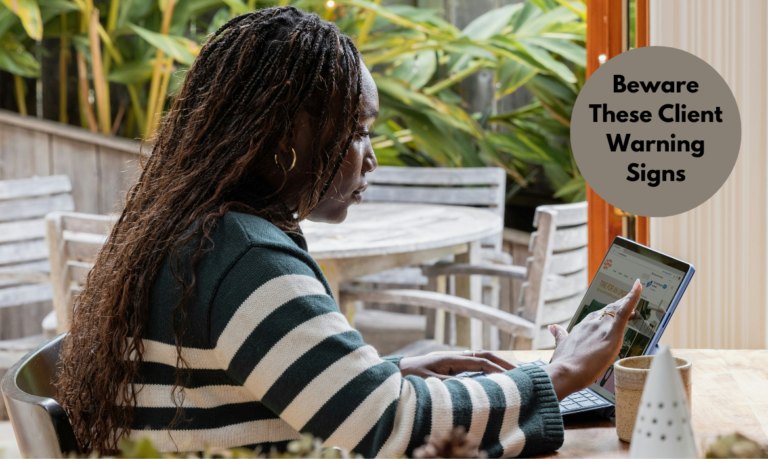At the risk of sounding like a dinosaur, I still remember the days before the World Wide Web existed.
Back then, demonstrating your writing credentials to a new editor involved sending freelance article pitches and physical clips (samples) of past work by snail mail—and enclosing a stamped, self-addressed envelope for their return.
Fortunately, things are much easier in today’s digital age for launching best writer websites.
Rather than rely on the vagaries of the postal service, your writer’s website can serve as your business card, portfolio, and storefront all in one.
What should you look for as you scour the best writer websites to inspire you? A good freelance writer portfolio and website allows you to showcase your best work, communicate what you can do to help freelance clients with their needs and attract new work opportunities through referrals and client testimonials.
What should a freelance writer’s website include?
Freelance writers’ websites are as variable as their owners, but there are a few key elements that should always be included as you’ll see in the following freelance writers website examples:
A home page
The best writer websites keep it friendly and welcoming, yet professional, and brief. Your website home page isn’t always the spot where searchers first land, but it needs to do the heavy lifting in terms of who are you and what you offer. Home pages can also highlight a handful of professional accomplishments. A the very minimum it should say who you are (your name, not just your business name), what you offer, and a sprinkling of your experience.
About page
A compelling ‘About’ page or a freelance writer ‘About Me’ page can set you apart from the competition. Here’s the spot to share your story, highlight relevant career history, and mention of what makes you unique. Including a ‘fun fact’ or two about yourself can reveal something of your personality, piquing a potential client’s interest. Just don’t overdo it, suggests copywriter and content strategist Tom Valcanis of I Sell Words. “(Some writers) infuse too much of their own personality into their own website, like it’s a personal blog,” he explains. “Having a little is fine, but the website should be customer-focused.”
Services page
Spell out what you do and for whom. Whether it’s freelance journalism, content writing, content marketing, ghostwriting, blogging, or proofreading, clients need to know that you can handle the type of freelance job they have in mind. Be specific about what you bring to projects, and what clients might expect from working with you.
A common mistake among writers is not providing enough information about their services and their process says copywriter Caitlin Wright, of TheWrightWords by Caitlin Wright. “I try to imagine people who come to me don’t really understand what a copywriter can do so I try to educate them on my website,” she says.
A portfolio page
Why do you need a freelance writer portfolio? It’s one of the core components if not the keystone to a freelance writers website that gets clients. A portfolio lets readers ‘try before they buy.’ It should feature a curated collection of your very best work. Daniel Gorlovetsky, founder and CEO of Israel’s TLVTech says a portfolio page is “super important” for writers. “It’s your personal showcase where you can show off your best work and let potential clients see what you’re all about,” he says. “Think of it like a fun resume that really highlights your writing style and skills.”
For more tips on how to craft a killer portfolio, read How to make your freelance writing portfolio stand out.
Contact details
Is there anything more frustrating than trying to find a contact email address or form on a website and jumping through hoops to get to it? Make it easy for potential clients to reach you, by including a contact form, email address, and social media links.
Failing to include contact details is a common mistake, especially for new writers, says freelance writer and editor Chuck Sambuchino. When writing a ‘Breaking In’ column for Writer’s Digest, he frequently had to switch to Plan B when the writer he wanted to feature couldn’t be reached. And it’s not enough to include just the publicist’s details. “You should include your own information — just in case it’s an urgent matter,” he writes.
What design elements should I consider when building my website?
A well-designed website should be fast, easy to navigate, and optimized for SEO, Gorlovetsky says. These freelance writers website examples have strong design elements you should think about.
Keep the design simple
“Using a simple CMS like WordPress or Ghost makes it easy to update content, and integrating a custom theme ensures it stays lightweight and on-brand,” he says. We’re also fans of Squarespace, Wix, to name other options.
Performance matters—things like fast load times, responsive design, and caching help boost traffic and improve SEO rankings, Gorlovetsky says.
“Mobile responsiveness is crucial since most visitors will come from their phones.”
Stick to brand colors, fonts, and logos
It should also look fresh and professional, says Wright, who created her website in 2018 and recently gave it a makeover.
“Part of this rebrand included a new logo and a color palette refresh,” she says. “So that was the catalyst for updating my website but once I got into it, I realized there were lots of things I needed to change.” Here’s how to create a personal freelance brand.
Over the years, Wright has refined her service offering, built her SEO skills, and worked to learn more about her audience.
The result? She now gets most of her work through her website thanks to SEO and an engaging tone. That’s why it’s one of our favorites on this list of freelance writers website examples.
Writers who don’t use photos of themselves on their site are missing an opportunity to connect on a one-on-one level with their audience, she suggests.
“I think it’s really important to show your face,” Wright says.
Say what you’ll do for your clients
Ghostwriter Stacy Ennis agrees that focusing on potential clients is key.
“Writing a book is a vulnerable endeavor, and I do my best to meet potential clients where they are and build trust through the content on the site, including through success stories and testimonials,” she explains.
“I also try to make it clear and easy for them to find the information they want and need, as well as provide value via my blog and podcast.”
These are some of the best writer websites to browse
Do some research and explore these freelance writers website examples before you refresh you freelance writer website so you have great visual elements and takeaways in mind to incorporate.
Writer’s name: Caitlin Wright
Best Writer Website: TheWrightWords by Caitlin Wright
Type of writer: Copywriter
What we like about this website: Wright’s recently-refreshed website is clean and fresh, with a casual headshot that immediately allows potential clients to put a face to the name. She’s ultra-clear about her niche (“I’m an award-winning website copywriter for communities and organizations that care for others”) and provides links to her different services (SEO copywriting, content marketing, small business copywriting, and freelance journalism) from the home page.
Writer’s name: Tom Valcanis
Best Writer Website: I Sell Words
Type of writer: Copywriter and content strategist
What we like about this website: Valcanis explains that his website was deliberately designed to showcase his skills in persuading through language. “I wanted something plain and simple, much like my brand name.” He uses minimal images and has intentionally used design elements to mimic the feel of reading on a pad of paper. “Yes, a picture tells a thousand words, but I’m here to write the thousand words!” he says.
Writer’s name: Ann Handley
Best Writer Website: Ann Handley
Type of writer: Content marketing writer
What we like about this website: Ann Handley’s website is infused with her high-energy personality but not in an overpowering way. It’s well-structured, easy to navigate, and showcases Handley’s marketing expertise by providing a video of her speaking at a major event. It also displays her other offerings, such as books and blog. The link to subscribe to her ‘Total Annarchy’ (pun intended) newsletter reveals a quirky sense of humor, and so prompts sign-ups.
Get pro tips on how to find more freelance content marketing clients.
Writer’s name: Michaela Trimble
Top Writer Website: Michaela Trimble
Type of writer: Travel and lifestyle journalist
What we like about this freelance writer website: From the whimsical artwork located ‘above the fold’ which orients the viewer to the stellar portfolio of clips from Vogue, Condé Nast Traveler, The Wall Street Journal, Travel + Leisure, and more, Trimble’s site is exquisitely stylish. A clear header menu provides quick links to ways in which visitors can work with Trimble – from coaching and consulting to joining writing and creative retreats.
Writer’s name: Jon Krakauer
Website: Jon Krakauer
Type of writer: Journalist and author
What we like about this website: As an accomplished mountaineer, author of several bestselling nonfiction books, including Into the Wild and Into Thin Air, and freelance contributor to high-profile titles including The New Yorker and the Wall Street Journal, Krakauer can afford to break the rules. (For example, he only lists his publicist’s contact details.) But as a bold, no-nonsense showcase of his interests and expertise, Krakauer’s website ticks all the boxes – and reflects his personality.
Writer’s name: Stacy Ennis
Best Ghostwriter Website: Stacy Ennis
Type of writer: Ghostwriter
What we like about this website: Stacy Ennis appeals to her ideal clients, by telling them what they want to hear (“Your story matters”) and how her services can help them scale their impact. It’s crisp, uncomplicated, and provides a quiz and resources for those who want to dip their toe in before taking the plunge. “A site doesn’t have to wow, but it should be clear, functional, and up to date,” she explains. “I also believe strongly that every writer should have a blog or some form of content. Not only does a blog highlight a writer’s skill and talent, but it builds trust with potential clients.”
Writer’s name: Paul Maplesden
Top Freelance Writer Website: Paul Maplesden
Type of writer: B2B content marketing writer
What we like about this website: Google ‘freelance content writer’ and Paul Maplesden pops up on the first page, demonstrating that he knows what he’s doing when he promises to write “SEO-optimised content” and to “get your business noticed”. His website isn’t exactly flash – there’s lots of text, minimal use of photography, and only the occasional accent color. But this only serves to prove the power of simplicity. You quickly get the sense that Maplesden isn’t one for bells and whistles. He knows what he’s doing and offers clients a brisk, no-nonsense service. Unusually, he even posts his rates for “short” to “epic” length text, in the interests of transparency.
Writer’s name: Kate Hogg
Top Writer Website: Kate Hogg
Type of writer: Scientific writer and editor
What we like about this website: Hogg is another writer who breaks the rules, with a simple one-page website built using Carrd. Its minimalist structure offers nothing in the way of frills, fluff, or clickable links. It just describes its owner as a “marine conservation consultant, editor and proofreader” and demonstrates Hogg’s on-the-ground experience through photographs rather than text. Her website will appeal only to clients who want her very specific expertise as it relates to technical reports and scientific manuscripts – and that’s just the way she likes it.
Writer’s name: Caroline Gibson
Best Writer Website: Caroline Gibson
Type of writer: copywriter and content writer
What we like about this website: Visitors to Caroline Gibson’s website don’t ever get to find out what she looks like. There are no photos whatsoever. However, they will be sold on her ability to write compelling content from the very second sentence on the home page which, you sense, is uttered with a cheeky wink (“Like the chocolate flake in a 99 ice-cream, I add more.”) The UK-based Gibson’s impressive roll call of clients features in a grid on her “Showcase” page and there’s a handy list of FAQs to guide newbies through the hiring process.
Writer’s name: Rupi Kaur
Best Writer’s Website: Rupi Kaur
Type of writer: poet
What we like about this website: Writing poetry had never seemed like the most lucrative career path – and then Rupi Kaur came along. Her visually bewitching website includes photographs of Kaur holding her books, as well as links to her shop selling prints, clothing, writing prompts, and even tattoos. Like Krakauer, Kaur is famous enough to leave out her personal contact details – only including those of her booking agent and publicist. More broadly, though, her website offers a masterclass on what is possible, from an artistic and monetization point of view, for writers with imagination and a desire to stand out from the crowd.
(Bonus)
Writer’s name: Diana Kelly Levey
Top Writer’s Website: Diana Kelly
Type of writer: Freelance journalist, content marketing writer, copywriter
What we like about the website: Diana launched her website initially as a portfolio hub and a way for clients to contact her, but then started sharing her freelance writing tips on her blog. (If you’re looking for a robust hub of blog posts that address freelance topics, you’ll probably find answers on this website.) She also features links to where she’s been quoted as a freelance expert in media on her About page and client testimonials on her Clients page. Borrow these ideas for your best freelance writers website.
(Levey owns and runs this website, Best Freelance Tips.)
Be sure to check out my website, Denise Cullen, for writer portfolio inspiration as well.
FAQs about best writer websites
Do I really need a writer website?
If you’re writing just for yourself, then no, you don’t need a writer website. But if you’re planning to write professionally, then a website is non-negotiable. A website serves as your primary online portfolio, building credibility and attracting clients.
Even if clients reach out to you via social media or freelance marketplaces, having a website is still crucial. That’s because it’s the one corner of the Internet over which you have complete control. Having this dedicated space allows you to oversee every aspect of your personal brand, and it’s impervious to changing social media algorithms.
What are the main website builders for writers?
WordPress powers almost half (43.6%) of all websites, and forms the building blocks for a staggering 493 million websites, the latest data from W3Techs suggests. It requires some technical know-how, particularly during setup, but it provides endless customization options, with thousands of themes (templates) along with free and paid plugins to enhance functionality.
Squarespace offers a visually appealing aesthetic, with solid built-in e-commerce and blogging features. But it’s not always thought to be as flexible as WordPress when it comes to customization—and has a higher price point.
Wix is good for beginners, with user-friendly drag-and-drop features. But tweaking the look and feel of your site can prove tricky.
Other website builders include Weebly, Webflow, and even Shopify (if you’re keen to monetize through selling products.)
What are the biggest website mistakes (according to writers and developers)?
Caitlin Wright reckons that trying to appeal to everyone is a common error some make when setting out to create their best writers website. Instead, niching down allows writers to attract more of their target audience who are specifically seeking the unique value that they can offer.
Stacy Ennis is constantly surprised at the number of dead pages out there —template pages that were never customized. Broken links are another big no-no. How do you fix these? Google Search Console flags broken links and errors that Google’s crawlers discover – and this is automatically updated every time Google crawls your site. Broken link plugins are also available.
Daniel Gorlovetsky describes mobile responsiveness as “crucial” so failing to consider how your website looks beyond your big screen view can be a real trap. As of September 2024, almost two-thirds (63.38%) of all website traffic comes from people using mobile devices.










